Table of Contents
- Introduction
- Editor’s Choice
- Global Disease Burden Statistics
- Leading Causes of Death Worldwide
- Non-Communicable Disease Statistics
- Communicable Disease Statistics
- Rare Disease Statistics
- Genetic Disease Statistics
- Global Spending on Disease and Disorders Statistics
- Initiatives for Disease Prevention Statistics
- Initiatives for Medicine Development
- Recent Developments
- Conclusion
- FAQs
Introduction
Disease Statistics: Diseases cover a broad spectrum of conditions that disrupt normal bodily functions with specific symptoms and physiological changes.
They range from infectious diseases caused by microorganisms to non-communicable diseases influenced by lifestyle and genetic factors. Along with autoimmune disorders triggered by abnormal immune responses.
Diseases spread through direct contact, contaminated objects, or airborne transmission. Impacting global health significantly by increasing healthcare costs and reducing productivity and quality of life.
Prevention involves vaccinations, public health measures, and lifestyle adjustments. While treatments include medications and surgeries.
Advances in genomics and digital health are transforming disease management. Yet challenges like antimicrobial resistance and healthcare accessibility remain.
Understanding these fundamentals is crucial for shaping effective healthcare and public health strategies worldwide.
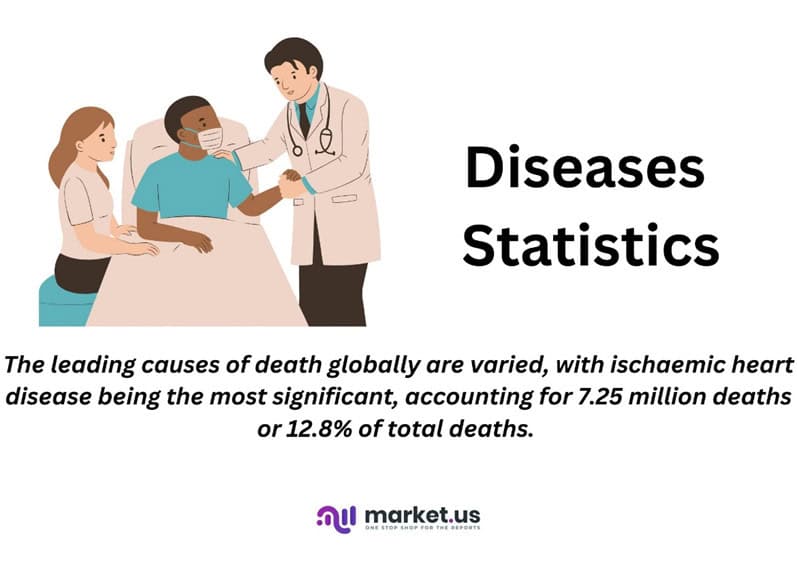
Editor’s Choice
- In the African Region, DALYs increased from 56,186.6 in 2020 to 59,266.6 in 2021.
- The total disease burden by cause has shown notable trends from 2015 to 2021. In 2015, injuries accounted for 10.12% of the total disease burden, communicable, maternal, neonatal, and nutritional diseases contributed 29.43%, and non-communicable diseases (NCDs) made up 60.46%.
- The leading causes of death globally are varied. With ischaemic heart disease being the most significant, accounting for 7.25 million deaths or 12.8% of total deaths.
- In 2021, the share of the total disease burden worldwide was dominated by various causes. Cardiovascular diseases were the leading cause, accounting for 14.9% of the total disease burden.
- As of 2012, the global distribution of deaths due to non-communicable diseases (NCDs) was dominated by cardiovascular diseases. Which accounted for 37% of all NCD-related deaths.
- The global disease burden from communicable, neonatal, maternal, and nutritional diseases has shown varying trends from 2017 to 2021, measured in Disability-Adjusted Life Years (DALYs) lost. Maternal disorders saw a gradual decline from 13.56 million DALYs in 2017 to 12.31 million in 2021.
- As of 2017, the prevalence rates of selected rare diseases worldwide, measured per 100,000 populations, vary significantly. Multiple Sclerosis has the highest prevalence, affecting 90 per 100,000 people.
- Long-Term Care Market accounted for USD 1100.7 Billion and is expected to reach around USD 2168.1 Billion in 2032. Between 2023 and 2032, this market is estimated to register a CAGR of 7.2%.
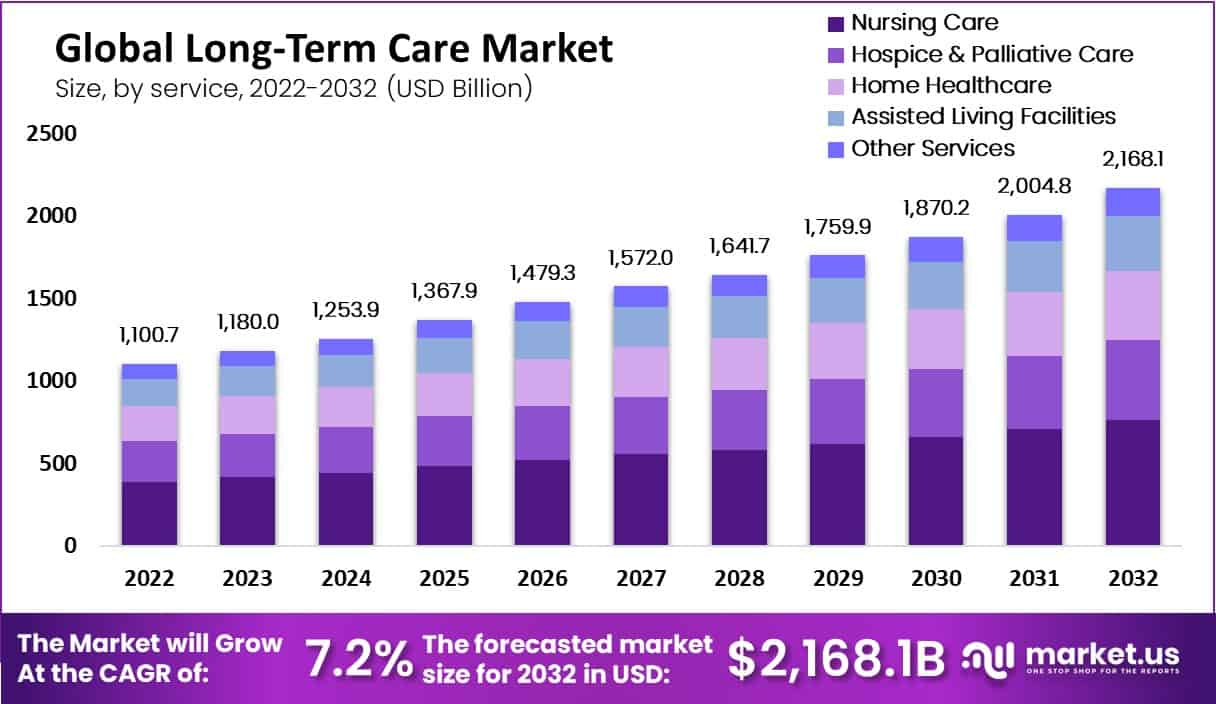
Global Disease Burden Statistics
Burden of Disease Worldwide Statistics
- In 2020 and 2021, the burden of disease measured in Disability-Adjusted Life Years (DALYs) per 100,000 individuals varied across different regions.
- In the African Region, DALYs increased from 56,186.6 in 2020 to 59,266.6 in 2021.
- The Eastern Mediterranean region saw a rise from 42,745.6 to 44,365.1 during the same period.
- Southeast Asia experienced an increase from 38,327.5 in 2020 to 39,996.7 in 2021.
- In the Americas, the DALYs grew from 30,362.1 to 31,417.5. While the European Region witnessed an increase from 25,990.0 to 26,948.6.
- The Western Pacific region also saw a slight rise from 23,268.3 in 2020 to 23,550.2 in 2021.
- This data highlights the varying levels of disease burden across different regions. With all regions experiencing an increase in DALYs over the two years.
(Source: Our World in Data)

Global Disease Burden – By Cause Statistics
- The total disease burden by cause has shown notable trends from 2015 to 2021.
- In 2015, injuries accounted for 10.12% of the total disease burden, communicable, maternal, neonatal, and nutritional diseases contributed 29.43%, and non-communicable diseases (NCDs) made up 60.46%.
- By 2016, injuries slightly decreased to 10.04%, while NCDs increased to 61.40%, and communicable, maternal, neonatal, and nutritional diseases dropped to 28.56%.
- This trend continued, with injuries and communicable diseases consistently declining and NCDs rising until 2019. In 2017, injuries were 10.02%, communicable diseases were 27.71%, and NCDs were 62.27%.
- In 2018, the percentages were 9.85% for injuries, 26.84% for communicable diseases, and 63.32% for NCDs.
- By 2019, injuries fell to 9.70%, communicable diseases to 26.01%, and NCDs increased to 64.29%.
- However, in 2020, there was a shift, with injuries at 9.12%. Communicable diseases rose to 28.16%, and NCDs decreased to 62.72%.
- This pattern persisted in 2021, with injuries further reducing to 8.83%. Communicable diseases increased to 29.61%, and NCDs dropped slightly to 61.56%.
- These data reflect the dynamic changes in the composition of the disease burden over the years.
(Source: Our World in Data)
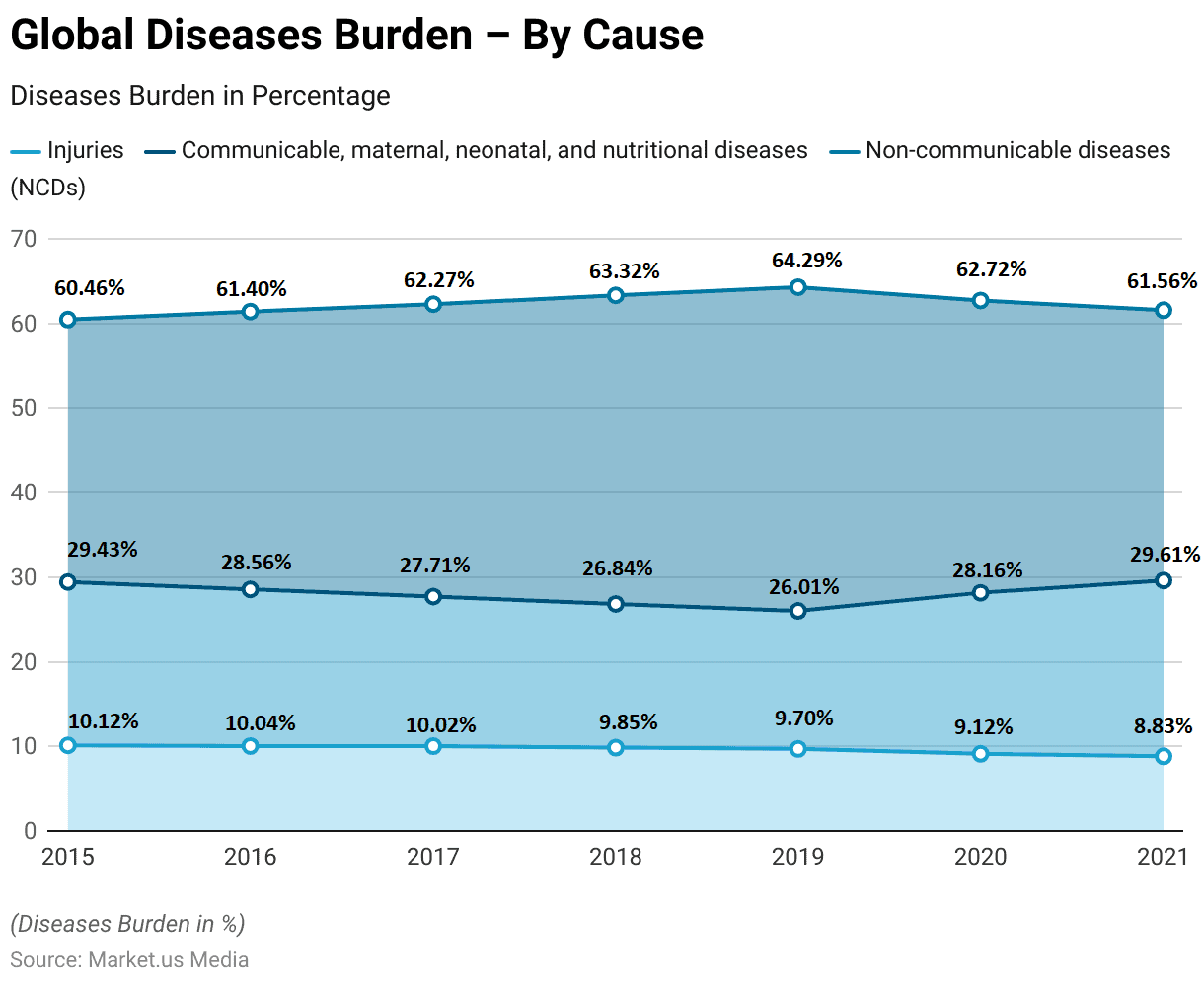
Leading Causes of Death Worldwide
Overall Causes
- The leading causes of death globally are varied, with ischaemic heart disease being the most significant, accounting for 7.25 million deaths or 12.8% of total deaths.
- Stroke and other cerebrovascular diseases follow closely, with 6.15 million deaths, representing 10.8%.
- Lower respiratory infections cause 3.46 million deaths, making up 6.1% of the total.
- Chronic obstructive pulmonary disease results in 3.28 million deaths (5.8%). While diarrhoeal diseases account for 2.46 million deaths (4.3%).
- HIV/AIDS contributes to 1.78 million deaths, or 3.1%.
- Trachea, bronchus, and lung cancers are responsible for 1.39 million deaths (2.4%). The same percentage as tuberculosis, which also causes 1.34 million deaths.
- Diabetes mellitus results in 1.26 million deaths, comprising 2.2% of the total, and road traffic accidents account for 1.21 million deaths, or 2.1%.
- These figures highlight the diverse causes contributing to global mortality rates.
(Source: Centers for Disease Control and Prevention)
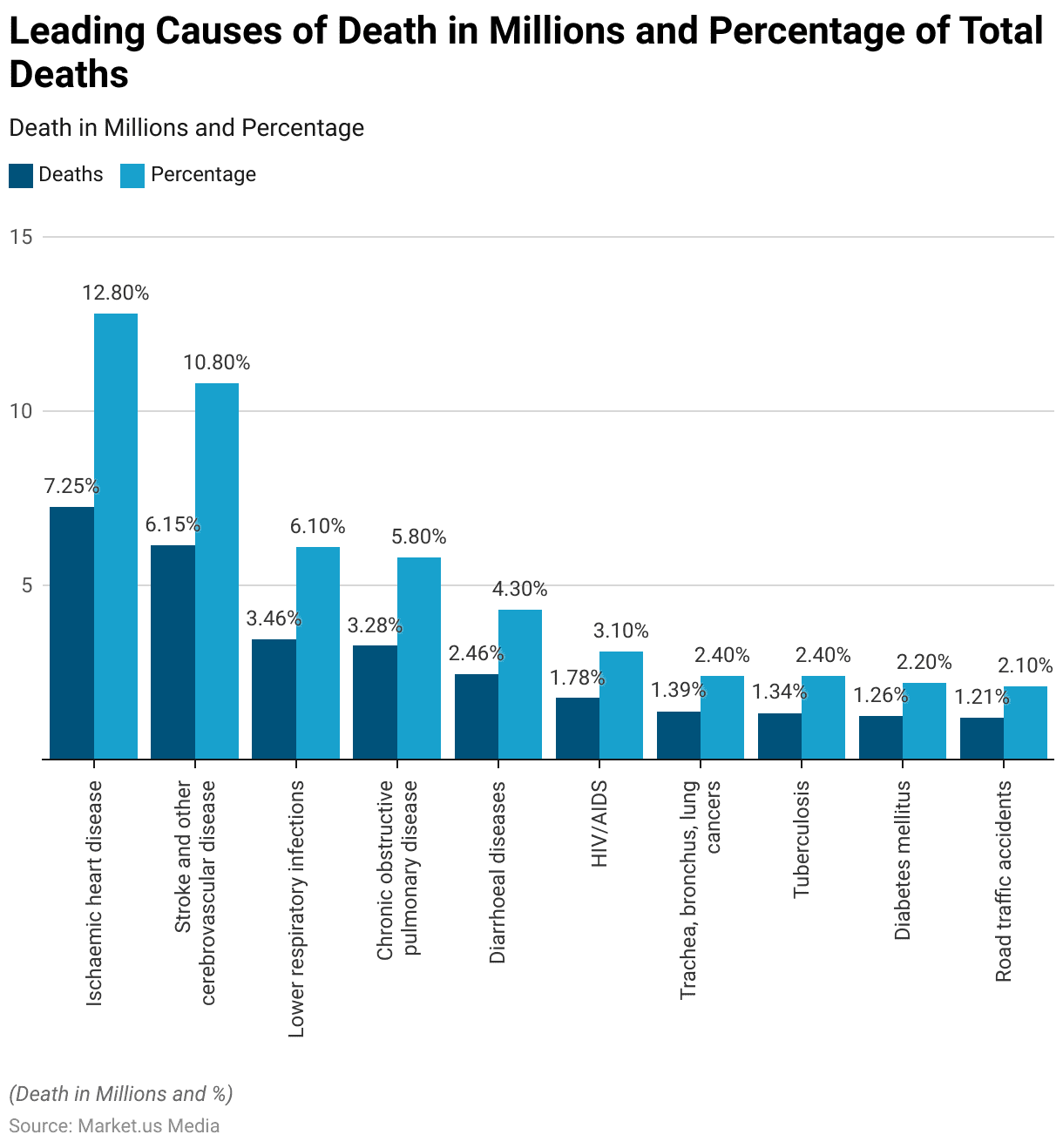
Share of Total Disease Burden – By Cause Statistics
- In 2021, the share of the total disease burden worldwide was dominated by various causes.
- Cardiovascular diseases were the leading cause, accounting for 14.9% of the total disease burden.
- Respiratory infections and tuberculosis (TB) followed closely, contributing 12.10%.
- Cancers accounted for 8.80% of the disease burden, while COVID-19 was responsible for 7.40%.
- Neonatal disorders contributed 6.50%, and musculoskeletal disorders accounted for 5.60%.
- Mental disorders made up 5.40%, and other non-communicable diseases (NCDs) comprised 4.90%.
- Diabetes and kidney diseases were responsible for 4.30% of the disease burden. With neurological disorders at 3.90% and respiratory diseases at 3.80%.
- Unintentional injuries accounted for 3.70%, digestive diseases accounted for 3.10%, and both enteric infections and malaria & neglected tropical diseases each contributed 2.50%.
- These figures illustrate the diverse causes impacting global health in 2021.
(Source: Our World in Data)
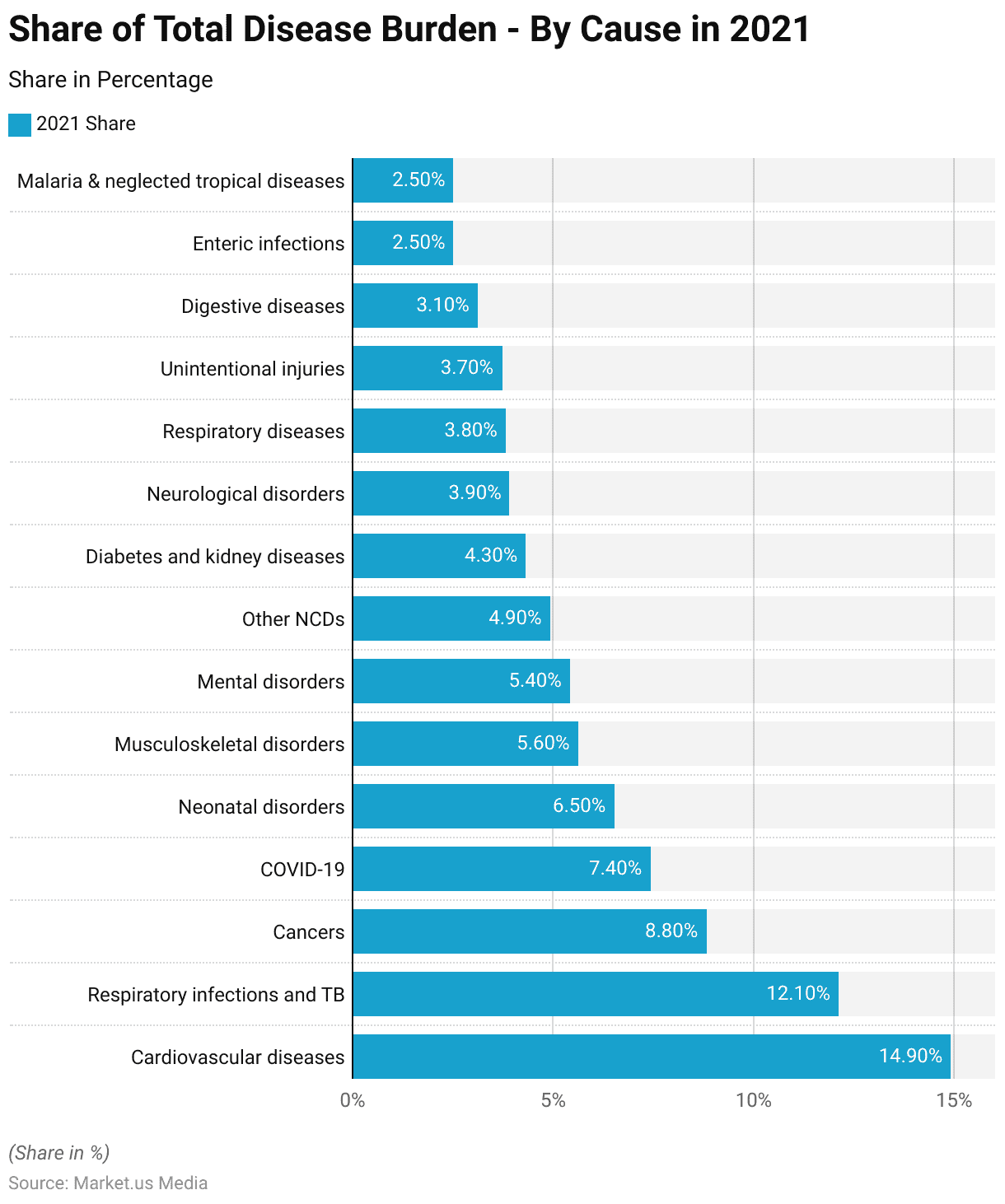
Non-Communicable Disease Statistics
DALY Rates from Non-Communicable Disease (NCDs) Statistics
- The Disability-Adjusted Life Years (DALY) rates due to Non-Communicable Diseases (NCDs) for various countries and regions show significant changes from 1990 to 2021.
- Overall, many countries experienced a reduction in DALY rates, indicating improvements in health outcomes despite global challenges.
- For instance, countries like Afghanistan, Algeria, and Andorra saw declines of around 20-30%, demonstrating effective healthcare interventions and public health strategies.
- Conversely, some areas like Bahrain and Cyprus witnessed larger declines of over 30%, suggesting robust healthcare improvements.
- Regions such as Latin America, the Caribbean, and East Asia & Pacific also showed notable decreases in DALY rates. Reflecting broader health advancements across diverse socio-economic contexts.
- However, disparities remain, with high-income countries generally showing lower rates compared to low-income regions. Highlighting ongoing global health inequalities that need addressing through targeted interventions and policy initiatives.
(Source: Our World in Data)
Burden from Non-Communicable Disease – By Sub-Category Statistics
- The global disease burden from non-communicable diseases (NCDs) has shown a notable increase across various categories from 2017 to 2021. Measured in Disability-Adjusted Life Years (DALYs) lost.
- Liver disease saw a gradual rise from 45.88 million DALYs in 2017 to 46.42 million in 2021.
- Mental disorders experienced a significant increase. From 134.72 million DALYs in 2017 to 155.42 million in 2021.
- Respiratory diseases also saw a steady rise from 102.13 million DALYs in 2017 to 108.50 million in 2021.
- Neurological disorders increased from 104.03 million DALYs in 2017 to 112.03 million in 2021.
- Cardiovascular diseases are the highest contributor. Escalated from 404.69 million DALYs in 2017 to 428.33 million in 2021.
- Skin diseases slightly increased from 40.44 million DALYs in 2017 to 41.94 million in 2021.
- Substance use disorders saw a modest rise from 31.00 million DALYs in 2017 to 32.54 million in 2021.
- Musculoskeletal disorders increased from 151.22 million DALYs in 2017 to 161.88 million in 2021. Cancers rose from 238.86 million DALYs in 2017 to 253.31 million in 2021.
- Digestive diseases showed a slight increase from 88.72 million DALYs in 2017 to 90.02 million in 2021.
- Other NCDs decreased slightly from 148.11 million DALYs in 2017 to 142.18 million in 2021.
- Diabetes and kidney diseases saw a significant rise from 109.13 million DALYs in 2017 to 123.70 million in 2021.
- These trends underscore the growing impact of NCDs on global health over the past five years.
(Source: Our World in Data)
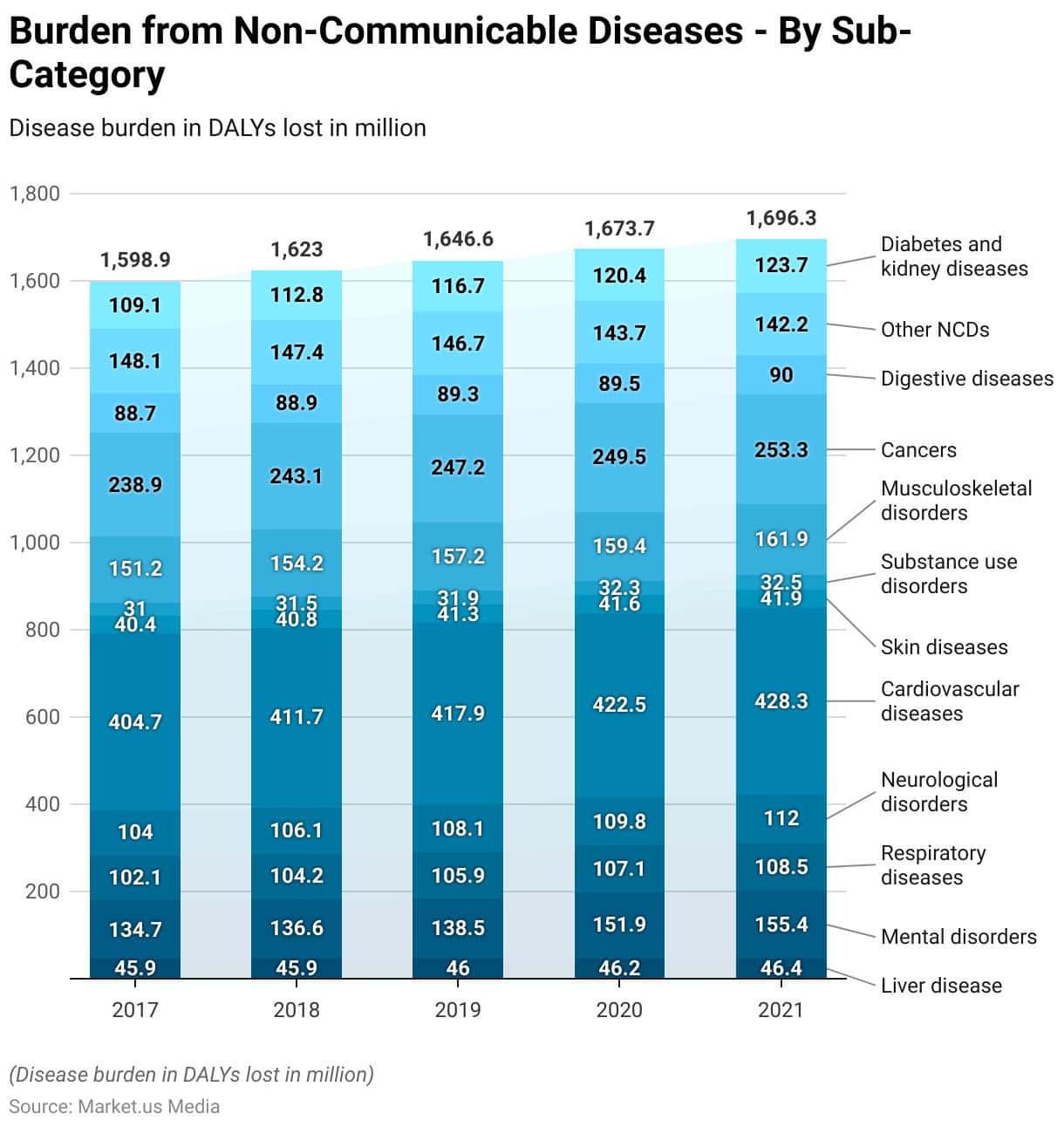
Distribution of Deaths Due to Non-Communicable Disease Statistics
- As of 2012, the global distribution of deaths due to non-communicable diseases (NCDs) was dominated by cardiovascular diseases. Which accounted for 37% of all NCD-related deaths.
- Malignant neoplasms followed, contributing to 27% of deaths.
- Respiratory diseases were responsible for 8% of the deaths, while diabetes mellitus accounted for 4%.
- Other non-communicable diseases made up the remaining 23% of deaths.
- These figures underscore the significant impact of cardiovascular diseases and malignant neoplasms on global mortality rates. Highlighting the need for targeted interventions and healthcare strategies to address these prevalent causes of death.
(Source: Statista)
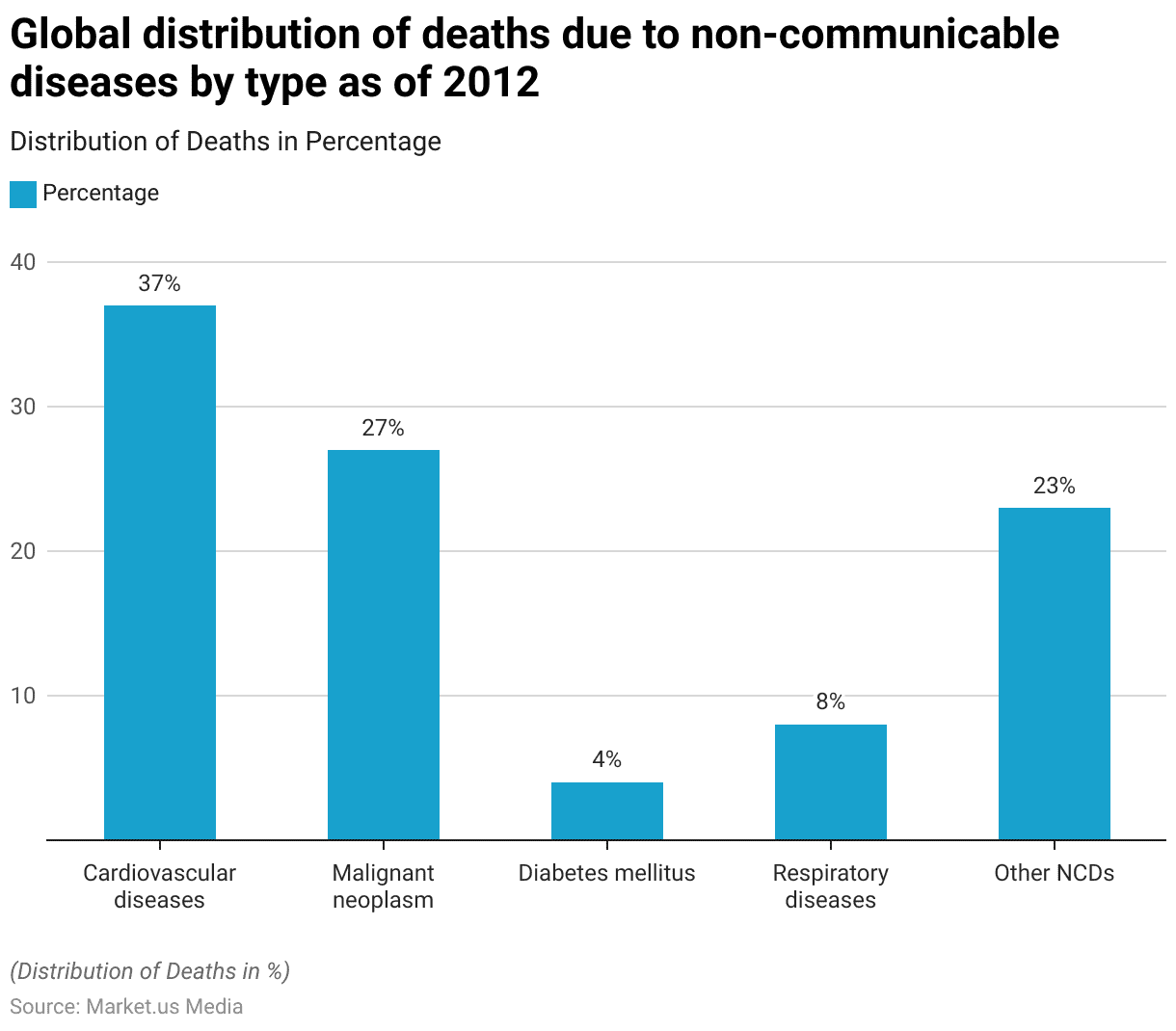
Disease Burden from Non-Communicable Disease – By Age Statistics
- The distribution of the global disease burden from non-communicable diseases (NCDs) by age group from 2017 to 2021 reveals significant trends.
- Among those aged 70 and above, the burden increased from 26.73% in 2017 to 27.99% in 2021.
- For individuals aged 56 to 69, the burden showed a slight but consistent rise from 34.33% in 2017 to 34.93% in 2021.
- The age group 15 to 49 experienced a gradual decrease, from 30.60% in 2017 to 29.97% in 2021.
- The burden among children aged 5 to 14 remained relatively stable. Decreasing slightly from 3.31% in 2017 to 3.19% in 2021.
- For children under 5, there was a notable decline from 5.03% in 2017 to 3.93% in 2021.
- These data highlight the increasing burden of NCDs among older age groups while showing a decline in younger populations over the five years.
(Source: Our World in Data)

Prevalence of Non-Communicable Disease and Risk Factors Among Working Women Statistics
- The prevalence of non-communicable diseases (NCDs) and their risk factors among working women shows significant variability.
- Coronary heart disease has the lowest prevalence, ranging from 0.3% to 5.9%.
- Diabetes mellitus affects between 8.9% and 16.0% of working women.
- Hypertension is notably prevalent, with rates ranging from 16.6% to 66.4%.
- Dyslipidemia prevalence varies between 27.8% and 44.0%.
- Overweight and obesity rates are particularly high, ranging from 33.8% to 77.0%.
- Additionally, an unhealthy diet is prevalent among 44.9% to 69.9% of working women.
- These figures highlight the widespread presence of NCDs and their risk factors in this demographic. Underscoring the need for targeted health interventions.
(Source: Research Gate)
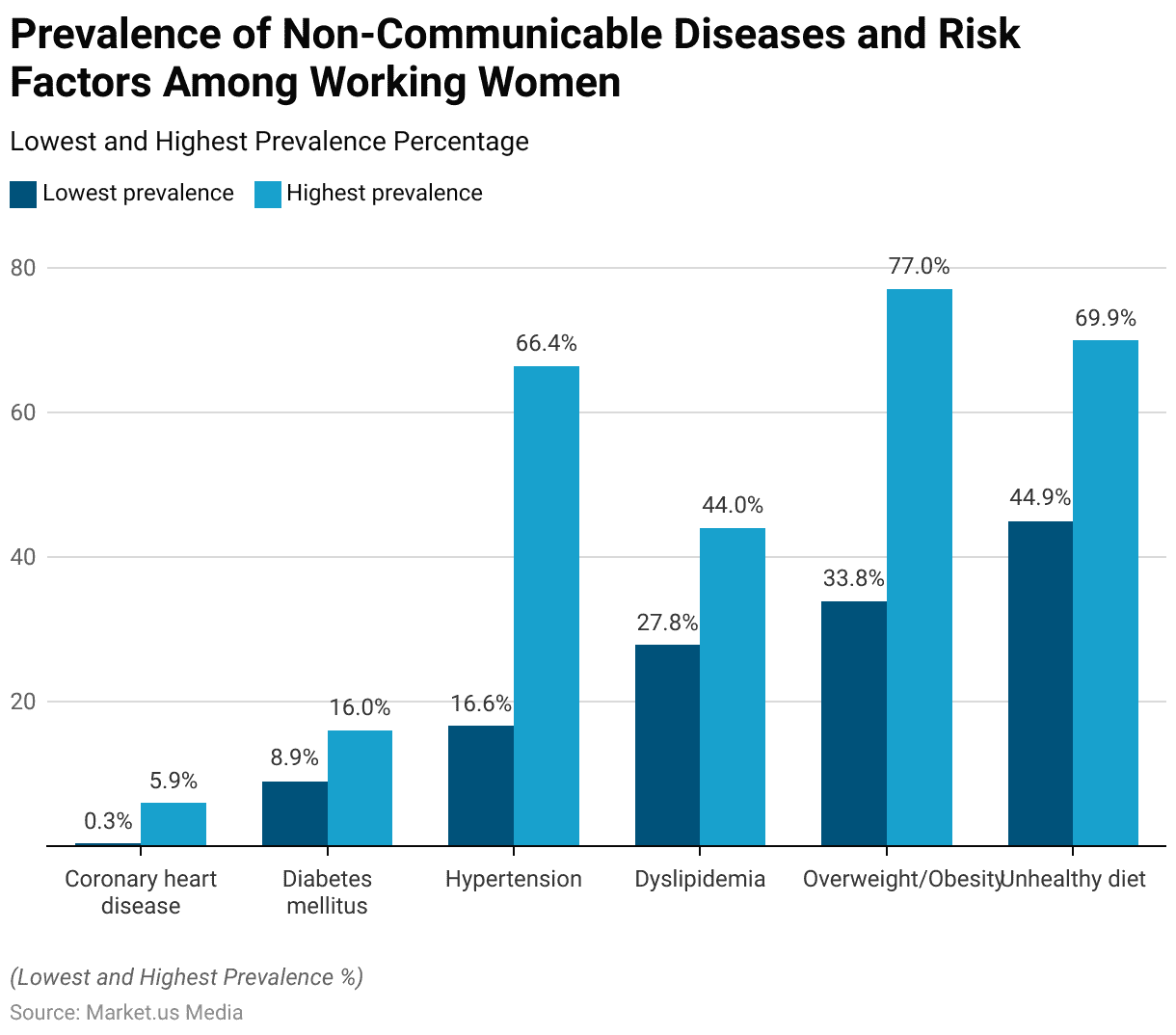
Communicable Disease Statistics
Global Communicable, Neonatal, Maternal, and Nutritional Disease Burden – By Specific Cause Statistics
- The global disease burden from communicable, neonatal, maternal, and nutritional diseases has shown varying trends from 2017 to 2021. Measured in Disability-Adjusted Life Years (DALYs) lost.
- Maternal disorders saw a gradual decline from 13.56 million DALYs in 2017 to 12.31 million in 2021.
- Nutritional deficiencies also decreased, from 52.98 million DALYs in 2017 to 48.92 million in 2021.
- Other infectious diseases experienced a significant reduction from 60.7 million DALYs in 2017 to 41.58 million in 2021.
- Similarly, the burden of HIV/AIDS and STIs dropped from 55.14 million DALYs in 2017 to 48.22 million in 2021.
- Malaria and neglected tropical diseases fluctuated, with a slight decrease from 68.78 million DALYs in 2017 to 66.85 million in 2019, followed by an increase to 71.63 million in 2021.
- Enteric infections decreased from 88.78 million DALYs in 2017 to 71.93 million in 2021.
- Respiratory infections and tuberculosis (TB) saw a sharp increase. From 170.44 million DALYs in 2017 to 349.68 million in 2021, likely influenced by the COVID-19 pandemic.
- Neonatal disorders consistently declined from 212.44 million DALYs in 2017 to 186.37 million in 2021.
- These trends highlight significant progress in some areas, while others, particularly respiratory infections and TB, have seen a marked increase in disease burden.
(Source: Our World in Data)
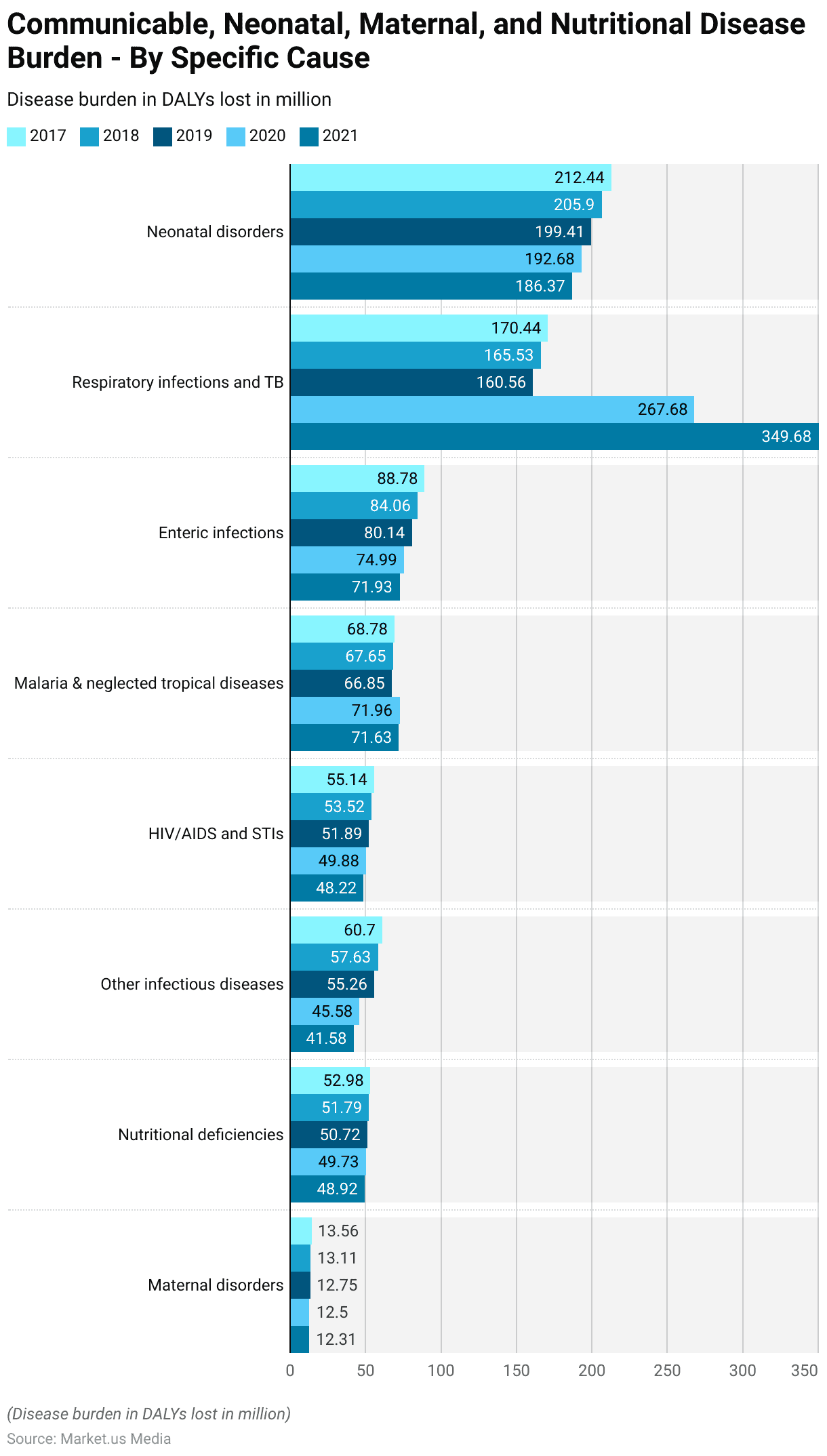
Global Communicable, Neonatal, Maternal, and Nutritional Disease Burden – By Age Statistics
- The disease burden from communicable, neonatal, maternal, and nutritional diseases by age group from 2017 to 2021 exhibits distinct trends.
- In individuals aged 70 and above, the burden increased from 4.91% in 2017 to 11.11% in 2021.
- For those aged 56 to 69, the burden rose from 7.77% in 2017 to 16.81% in 2021.
- The age group 15 to 49 saw an increase from 20.60% in 2017 to 24.87% in 2021.
- Conversely, the burden for children aged 5 to 14 remained relatively stable. Decreasing slightly from 6.89% in 2017 to 5.59% in 2021.
- The most significant decrease was observed in children under 5. Where the burden dropped from 59.83% in 2017 to 41.62% in 2021.
- These shifts indicate a growing impact of these diseases on older age groups. While the burden among the youngest population has notably decreased over the five years.
(Source: Our World in Data)
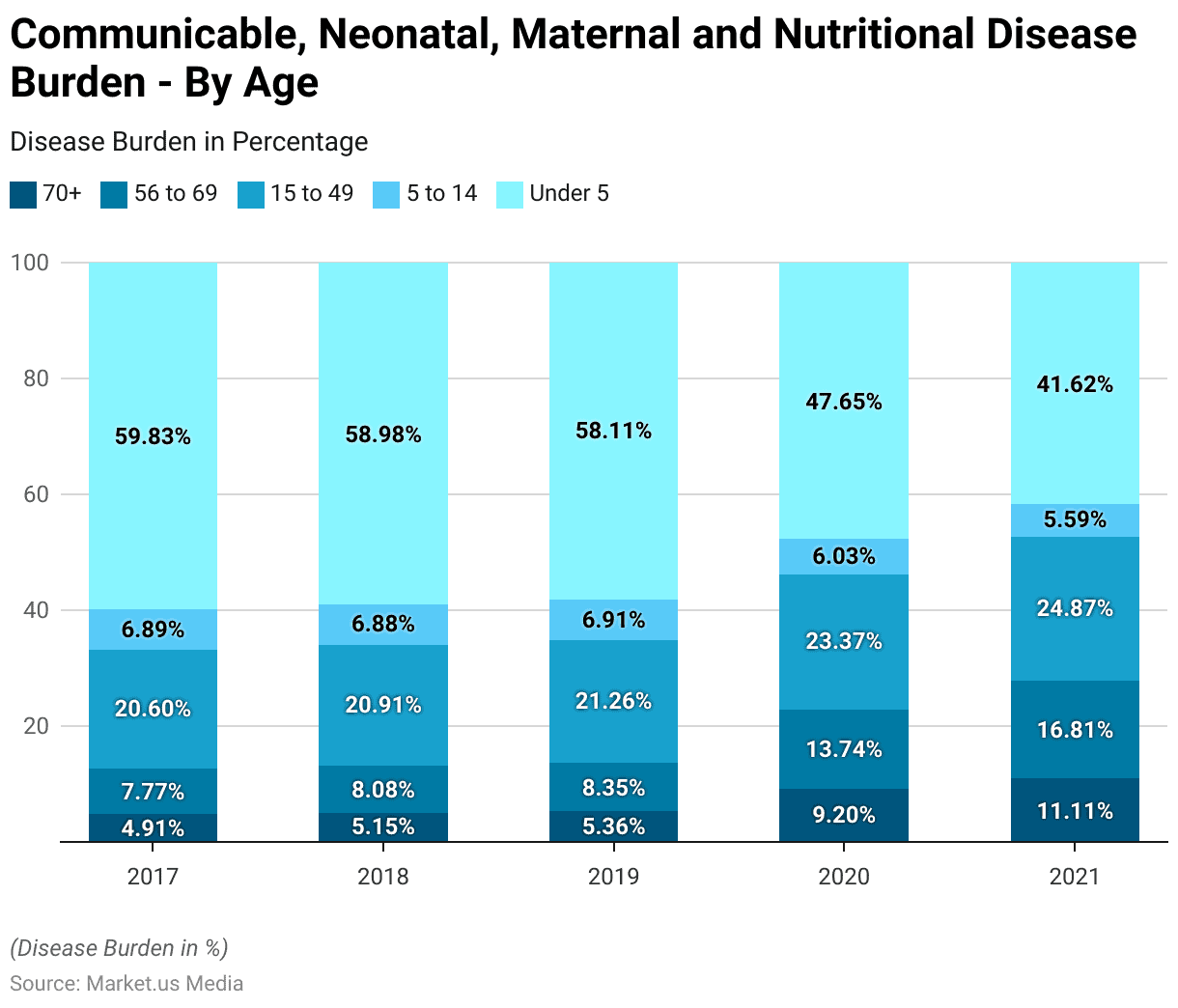
Rare Disease Statistics
Prevalence Rate of Selected Rare Disease Worldwide Statistics
- As of 2017, the prevalence rates of selected rare diseases worldwide, measured per 100,000 populations, vary significantly.
- Multiple Sclerosis has the highest prevalence, affecting 90 per 100,000 people.
- Narcolepsy follows with a prevalence rate of 50 per 100,000, while Primary Biliary Cholangitis affects 40 per 100,000.
- Fabry Disease has a prevalence of 30 per 100,000, and Cystic Fibrosis affects 25 per 100,000 individuals.
- Hemophilia has a prevalence of 20 per 100,000, with Spinal Muscular Atrophy and Retinal Dystrophy each affecting 13 per 100,000.
- X-linked hypophosphatemia has a prevalence rate of 5 per 100,000, and Urea Cycle Disorders, Pulmonary Arterial Hypertension, and Cerebral Adrenoleukodystrophy each affect 3 per 100,000 people.
- Hereditary Angioedema has a prevalence of 2 per 100,000, AA Amyloidosis affects 1.5 per 100,000, and Cushing’s Syndrome affects 1 per 100,000.
- Both Paroxysmal Nocturnal Hemoglobinuria (PNH) and Morquio Syndrome have the lowest prevalence, each affecting 0.16 per 100,000 people.
- These rates highlight the varying degrees of rarity and the global impact of these diseases.
(Source: Statista)

Genetic Disease Statistics
- Single-gene diseases, such as Achondroplasia, Beta-thalassemia, Cystic fibrosis, Fragile X syndrome, Huntington’s disease, Sickle cell disease (SCD), and Hemophilia. Exhibit varying rates of occurrence across different populations.
- Achondroplasia, causing short-limbed dwarfism, occurs in approximately 1 in 15,000 to 40,000 births.
- Beta-thalassemia, prevalent among those from Mediterranean, North African, Middle Eastern, Indian, Central Asian, and Southeast Asian backgrounds, affects a significant portion of these populations.
- Cystic fibrosis is characterized by respiratory and digestive complications. Varies with 1 in 2500 to 3500 White Americans, 1 in 17,000 African Americans, and 1 in 31,000 Asian Americans affected.
- Fragile X syndrome, leading to developmental issues, affects about 1 in 4000 males and 1 in 8000 females.
- Huntington’s disease, causing progressive brain disorders, occurs at rates of 3 to 7 per 100,000 people of European descent, less commonly in Japanese, Chinese, and African populations.
- SCD, a genetic condition primarily affecting those of African descent, impacts about 1 in 365 newborn African Americans, 1 in 16,300 Hispanic Americans, 1 in 25,800 Asian/Pacific Islanders, and 1 in 41,600 non-Hispanic Whites.
- Hemophilia, a bleeding disorder, primarily affects males, with approximately 1 in 5,617 male births having hemophilia A and 1 in 19,283 having hemophilia B in the US.
(Source: Gene Home)
Global Spending on Disease and Disorders Statistics
Spending on Medicine – According to Country
- By 2026, projected spending on medicine in selected countries worldwide is expected to vary significantly.
- In the United States, the maximum spending estimate is projected to reach $715 billion. With a minimum estimate of $685 billion.
- China is expected to spend between $190 billion and $220 billion.
- Germany’s spending is projected to range from $76 billion to $96 billion. While Japan’s estimates fall between $75 billion and $93 billion.
- France’s spending is projected to be between $48 billion and $52 billion, and Brazil is expected to spend between $47 billion and $51 billion.
- In the United Kingdom, the projected spending ranges from $46 billion to $50 billion.
- Italy is estimated to spend between $41 billion and $45 billion, and India between $37 billion and $41 billion.
- Spain and Canada are both projected to spend between $32 billion and $36 billion.
- Russia’s spending estimates range from $27 billion to $31 billion, South Korea’s from $21 billion to $25 billion, and Australia’s projected spending is between $15 billion and $17 billion.
- These projections highlight the varying levels of investment in medicine across different countries, reflecting their healthcare priorities and economic capabilities.
(Source: Statista)
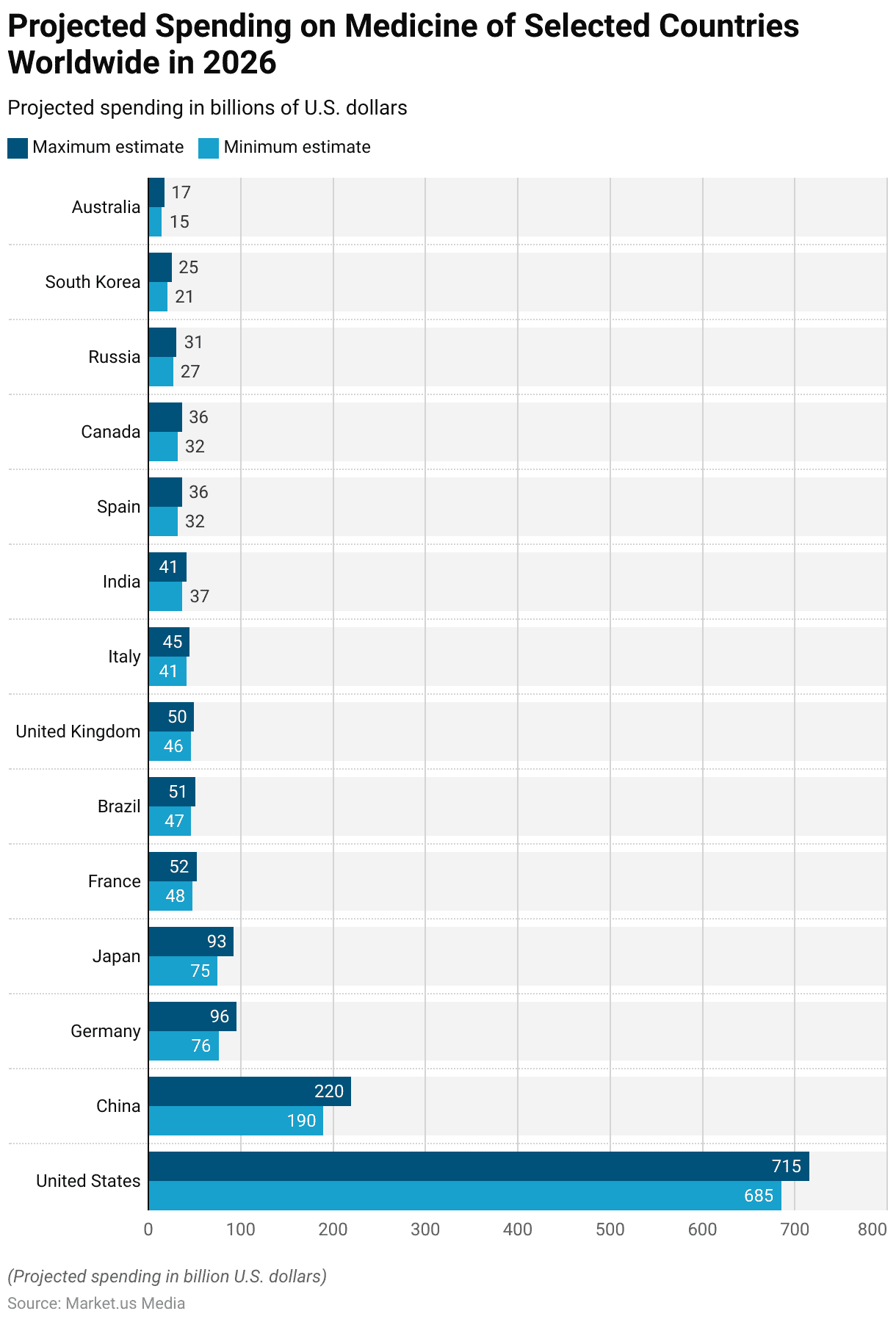
Global Autoimmune Disorders Spending
- From 2011 to 2023, global spending on autoimmune disorders has seen a substantial increase. In 2011, the expenditure was $23 billion, rising to $28 billion in 2012.
- This upward trend continued, with spending reaching $32 billion in 2013, $40 billion in 2014, and $49 billion in 2015.
- By 2016, spending had grown to $58 billion, further increasing to $69 billion in 2017 and $80 billion in 2018.
- The expenditure continued to climb, reaching $94 billion in 2019 and $108 billion in 2020.
- The trend persisted, with spending rising to $127 billion in 2021, $141 billion in 2022, and finally $149 billion in 2023.
- This significant growth highlights the increasing financial commitment to managing and treating autoimmune disorders globally.
(Source: Statista)
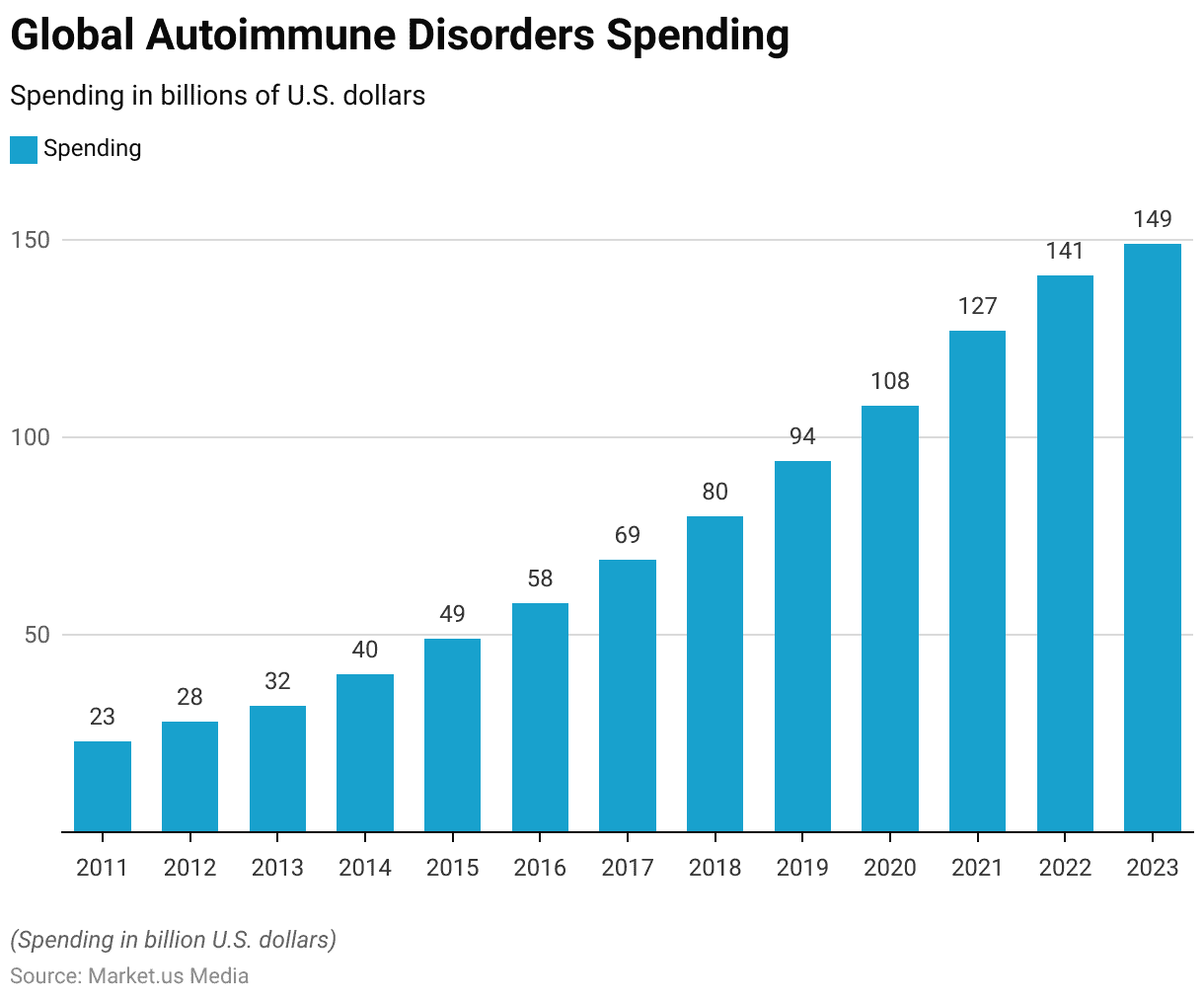
Research and Development Spending
- In 2022, a total of $3,931 million was donated for research and development across various diseases.
- The largest share was allocated to HIV/AIDS, receiving $1,352 million. Tuberculosis research received $702 million, followed by malaria with $604 million.
- Diarrhoeal diseases were allocated $156 million, while kinetoplastids received $123 million.
- Worms and flukes research was funded with $104 million. Dengue received $82 million. Salmonella infections and bacterial pneumonia/meningitis were allocated $80 million and $48 million, respectively.
- Hepatitis B research received $30 million, and snakebite envenoming was funded with $21 million. Hepatitis C and leprosy received $16 million and $14 million, respectively.
- Lesser-funded areas included cryptococcal meningitis ($6.6 million), histoplasmosis ($3.4 million), rheumatic fever ($3.4 million), scabies ($1.9 million), leptospirosis ($1.2 million), Buruli ulcer ($0.6 million), mycetoma ($0.5 million), and trachoma ($0.2 million).
- Additionally, platform technologies received $194 million, multi-disease vector control products $63 million, core funding for a multi-disease R&D organization $249 million, and other R&D projects $73 million.
- This allocation highlights the diverse focus areas in global health research and the significant investment in combating a wide range of diseases.
(Source: Statista)
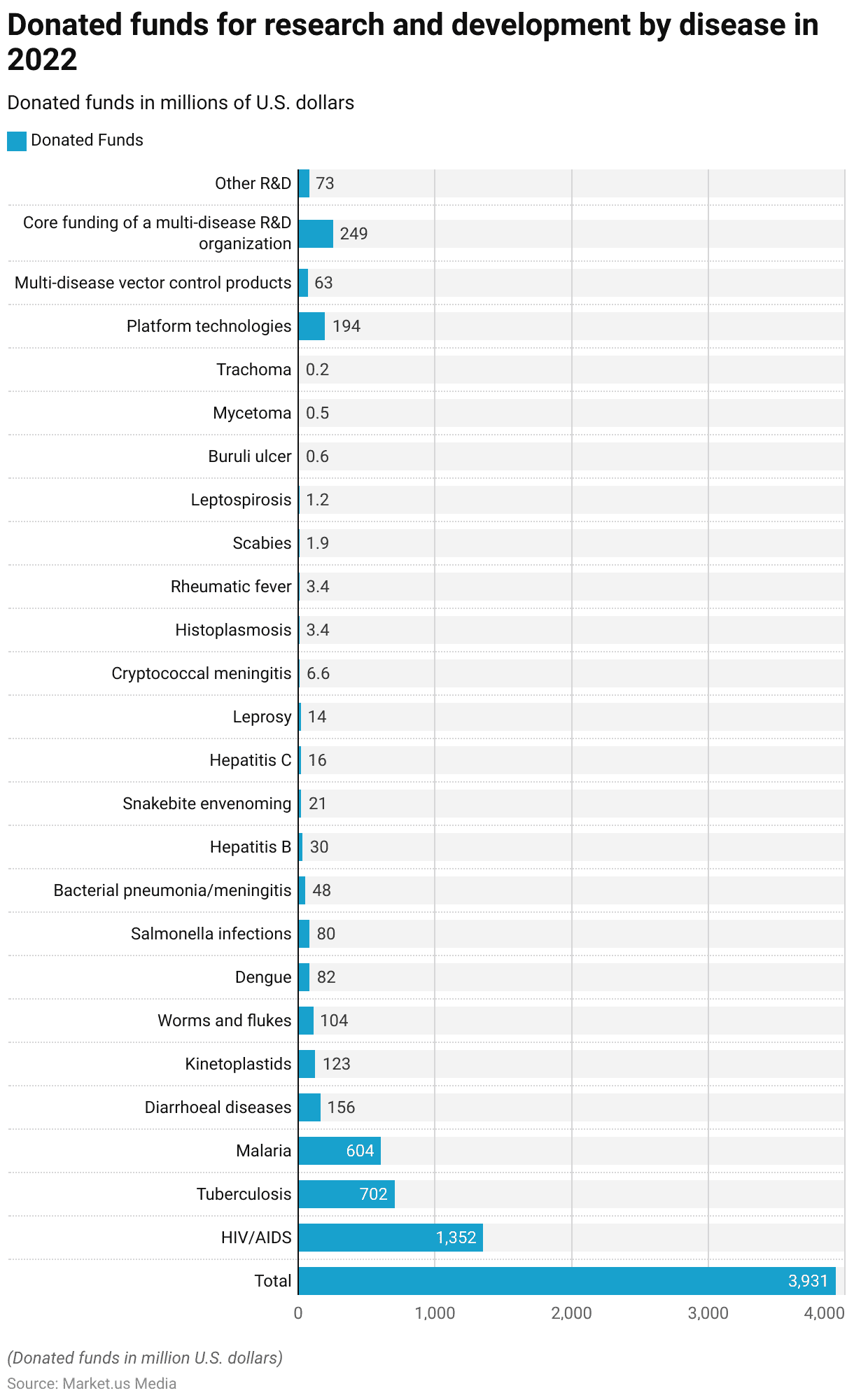
Initiatives for Disease Prevention Statistics
- In 2023, several key initiatives for disease prevention have been implemented globally. Focusing on reducing the incidence and impact of various diseases through coordinated efforts.
- The Healthy People 2030 initiative by the U.S. Department of Health and Human Services sets data-driven national objectives to improve health and well-being over the next decade. Emphasizing equitable long-term recovery and resilience, health literacy, and nutrition and physical activity guidelines.
- Additionally, the American College of Preventive Medicine (ACPM) has launched multiple programs aimed at chronic disease prevention. Including initiatives targeting brain health, diabetes prevention, hypertension reduction, and cancer prevention.
- These efforts, alongside continuous support for vaccine confidence and preventive medicine education, illustrate a comprehensive approach to disease prevention that involves policy advocacy, public health promotion, and professional development.
- These initiatives collectively aim to improve health outcomes by addressing social determinants of health, promoting healthy lifestyles, and enhancing access to preventive care.
(Source: Healthy People, U.S. Department of Health and Human Services, Center for Disease Control & Prevention)
Initiatives for Medicine Development
Medicine development initiatives in 2023 have focused on advancing research and enhancing the efficiency of healthcare delivery.
- The National Institutes of Health (NIH) continues to be a pivotal force, investing approximately $45 billion annually in biomedical research to drive discoveries and innovations that improve health outcomes.
- Significant initiatives include the Defense Health Agency’s strategic plan aimed at modernizing military healthcare through cutting-edge technologies and integrated systems to enhance patient care and readiness.
- Johns Hopkins Medicine’s “Innovation 2023” strategic plan emphasizes leveraging digital platforms, optimizing data integration, and fostering community engagement to improve health outcomes and patient satisfaction.
- Duke University’s Science and Technology initiative, with a $100 million investment, focuses on resilience in body and brain health, harnessing advances in genomics, data science, and artificial intelligence to pioneer new treatments and therapies.
- Additionally, the National Cancer Institute’s initiatives, such as the ALCHEMIST trial, aim to identify molecular alterations in lung cancer for targeted treatments, highlighting the ongoing efforts to personalize and improve cancer care.
- These diverse initiatives underscore a global commitment to advancing medical research, developing innovative treatments, and enhancing healthcare delivery systems.
(Sources: National Institutes of Health, Johns Hopkins Medicine, Health.mil, Duke University School of Medicine, National Cancer Institute)
Recent Developments
Acquisitions and Mergers:
- Pfizer acquires Trillium Therapeutics: In early 2023, Pfizer acquired Trillium Therapeutics for $2.3 billion to enhance its portfolio in immuno-oncology, focusing on treatments for blood cancers such as leukemia and lymphoma.
- Merck acquires Pandion Therapeutics: Merck completed the acquisition of Pandion Therapeutics for $1.85 billion in late 2023. This acquisition aims to expand Merck’s pipeline of treatments for autoimmune diseases.
New Product Launches:
- Moderna’s mRNA-1234 Vaccine: Moderna launched its mRNA-1234 vaccine in early 2024 to target multiple strains of the influenza virus, utilizing advanced mRNA technology for improved efficacy.
- Gilead’s Lenacapavir: Gilead Sciences introduced Lenacapavir in mid-2023, a long-acting injection for the treatment of HIV, aiming to reduce the frequency of dosing and improve patient adherence.
Funding:
- NIH allocates $500 million for Alzheimer’s research: In 2023, the National Institutes of Health (NIH) allocated $500 million to fund research initiatives focused on finding treatments and a potential cure for Alzheimer’s disease.
- Bill & Melinda Gates Foundation commits $200 million: The Bill & Melinda Gates Foundation committed $200 million in 2024 to combat malaria and accelerate the development of new treatments and vaccines.
Technological Advancements:
- AI in Disease Prediction: Researchers are increasingly using artificial intelligence to predict disease outbreaks and progression. AI models are being developed to forecast the spread of infectious diseases such as COVID-19 and influenza. Helping in early intervention and resource allocation.
- CRISPR Gene Editing: Advances in CRISPR gene-editing technology are being applied to treat genetic disorders like sickle cell disease and cystic fibrosis. Clinical trials are showing promising results in correcting defective genes.
Market Dynamics:
- Growth in Telemedicine: The telemedicine market has grown significantly, driven by the need for remote healthcare services during the COVID-19 pandemic. This trend is expected to continue. With an estimated CAGR of 20% from 2023 to 2028.
- Rising Prevalence of Chronic Diseases: The prevalence of chronic diseases such as diabetes and cardiovascular diseases is increasing globally, leading to higher demand for long-term treatment solutions and healthcare services.
Regulatory and Strategic Developments:
- FDA’s Accelerated Approval Pathway: The FDA has expanded its accelerated approval pathway for treatments addressing unmet medical needs, allowing faster access to new therapies for conditions like rare cancers and genetic diseases.
- Global Health Initiatives: International organizations like the WHO are launching global health initiatives to address emerging health threats and improve disease surveillance and response capabilities.
Research and Development:
- Vaccine Development: Significant investments are being made in developing vaccines for infectious diseases such as tuberculosis, HIV, and dengue fever. Ongoing research aims to create more effective and longer-lasting vaccines.
- Personalized Medicine: R&D efforts are focusing on personalized medicine, which tailors treatments to individual genetic profiles. This approach is being applied in oncology, AI in Cardiology, and rare diseases to improve treatment outcomes.
Conclusion
Disease Statistics – The diseases industry, encompassing pharmaceuticals, biotechnology, and healthcare services. It is poised for growth driven by demographic shifts.
Technological advancements like genomics and personalized medicine, and lessons learned from the COVID-19 pandemic.
Challenges include rising costs, complex regulations, and healthcare disparities. Emerging trends such as precision medicine and digital health are reshaping care delivery, while ongoing innovations in biopharmaceuticals and AI promise transformative therapies.
Looking forward, strategic investments in R&D, adaptive business models, and collaborative partnerships will be crucial for navigating regulatory landscapes and achieving sustainable market growth.
FAQs
A disease is a condition that impairs the normal functioning of the body or mind, leading to symptoms and signs that disrupt normal activities and well-being. Infections, genetics, environmental factors, lifestyle choices, and other factors can cause diseases.
Non-communicable diseases (NCDs) are chronic conditions that are not transmitted from person to person. They include cardiovascular diseases, cancers, chronic respiratory diseases, and diabetes. NCDs are often caused by a combination of genetic, physiological, environmental, and behavioral factors.
Communicable diseases are transmitted through various modes. Such as direct contact with an infected person, and indirect contact through contaminated surfaces. Ingestion of contaminated food or water, inhalation of airborne pathogens, and vector-borne transmission (e.g., through mosquitoes or ticks) .
Autoimmune diseases occur when the immune system mistakenly attacks the body’s cells and tissues. Examples include rheumatoid arthritis, lupus, multiple sclerosis, and type 1 diabetes. The exact cause of autoimmune diseases is often unknown. However, they are thought to involve a combination of genetic and environmental factors.
Common symptoms of cardiovascular diseases include chest pain or discomfort, shortness of breath, fatigue, palpitations, and swelling in the legs or abdomen. These symptoms can indicate conditions such as coronary artery disease, heart failure, or arrhythmias.
Discuss your needs with our analyst
Please share your requirements with more details so our analyst can check if they can solve your problem(s)



